Mastering Personalized Customer Experiences for Greater Engagement
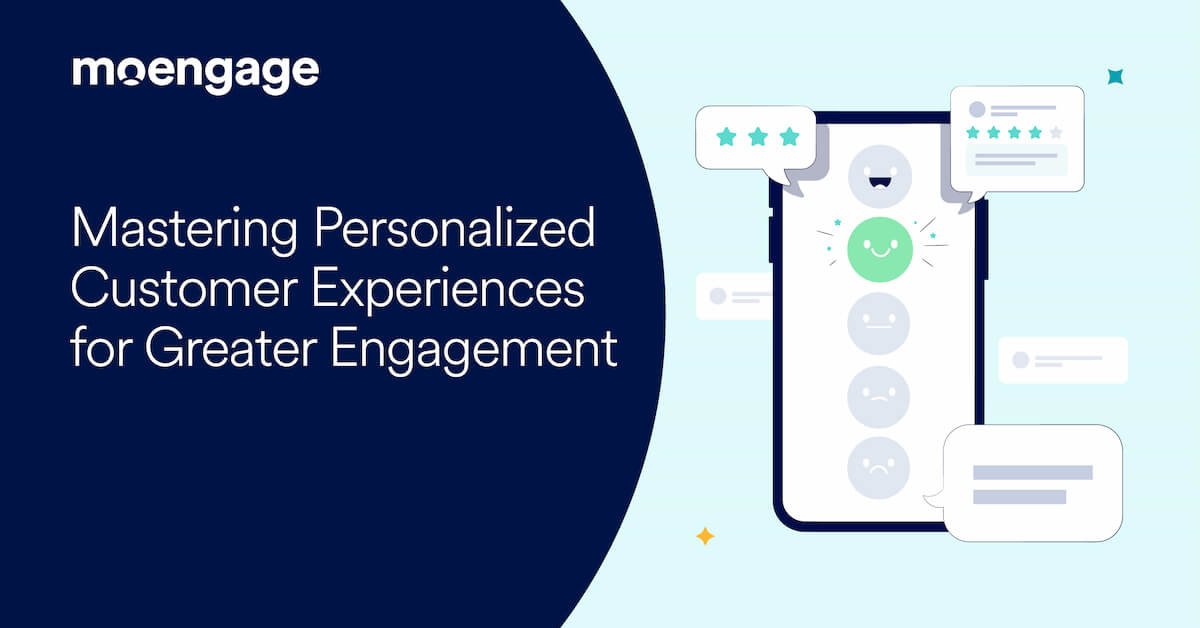
Reading Time: 11 minutes
At this point, personalization is no longer a nice addition, it’s a must-have. Consumers expect it, and it’s a vital marketing tool for fostering engagement, building brand loyalty, and driving conversions and revenue.
According to our Personalization Pulse Check Report, 56% of U.S. and Canadian consumers expect a curated shopping experience from brands they shop from regularly. More tellingly, 76% of North American consumers said that receiving personalized communications was a key factor in prompting their consideration of a brand.
Long story short; if you aren’t offering personalized customer experiences from start to finish, you’re failing to meet your customers’ expectations (and falling behind your competition).
To help you build hyper-personalized, targeted customer experiences that connect with your audience, we cover the following:
- What is a personalized customer experience?
- The impact of personalization on customer experience
- Six personalized customer experience examples
- How to personalize customer experience: a strategy
Let’s get to it.
What is a Personalized Customer Experience?
A personalized customer experience refers to curating an end-to-end user journey that considers customers’ individual preferences and past behavior. The aim is to improve customer satisfaction and drive engagement, retention, and conversions.
It’s a core component of broader personalized marketing efforts and includes areas such as website personalization, customer journey mapping, and customized messaging (whether that’s via email, SMS, or push notifications).
The Impact of Personalization on Customer Experience
A personal touch makes customers feel valued, heard, and truly appreciated. And when customers feel truly appreciated, they reciprocate that feeling towards the brands they love.
Personalized experiences — from content, to channels, to timing, to complete user journeys — is extremely vital to achieving customer satisfaction that keeps users around for the long haul.
Let’s look at why personalization is so important for developing a high-quality customer experience.
- Enhances the overall experience: A personalized end-to-end experience ensures customers get the best version of your product or service for them.
- Improves satisfaction and retention: Tailored experiences provide customers with their optimal experience, drastically improving satisfaction and (in turn), customer retention.
- Drives active engagement: Targeted marketing campaigns that speak directly to customers’ needs result in better lead nurture and result in higher conversions.
- Develops brand trust and loyalty: Satisfied customers connect with your brand and remain loyal and devoted, advocating on behalf of your brand for you.
- Increases conversions and revenue: Quite simply, personalized experiences translate into more conversions by driving more customers to purchase, increasing average order value (AOV), customer lifetime value (CLV), and revenue.
When it comes down to it, personalization can be the difference between one-time buyers and loyal, devoted customers who advocate unwaveringly for your brand.
Six Personalized Customer Experience Examples
Did you know that 39.5% of B2C brands said that delivering personalized experiences was a key challenge for them in a recent survey?
The fact is, personalized experiences are extremely difficult to get right; but when you do, they translate into a major success.
That’s why leading brands spend countless hours and pay rigorous attention to detail to get things perfect. But how are some of the biggest brands effectively personalizing their customer experiences and marketing campaigns to maximize engagement and increase loyalty? What strategies and tactics do they employ, and how granular do they get in the planning and execution of these tactics?
We explore some of the best-personalized customer experience marketing examples below.
1. Amazon leverages big data to power personalized product recommendations
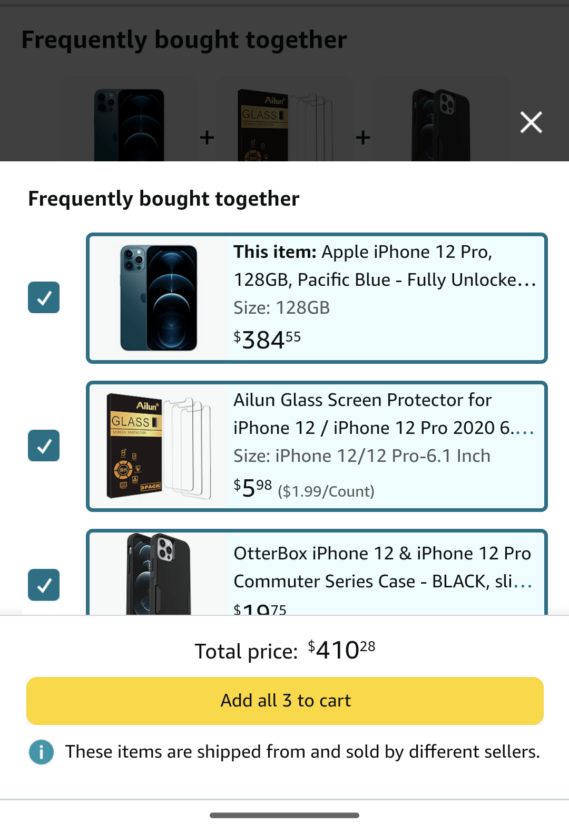
Amazon is an Ecommerce behemoth and is often considered the shining example for Ecommerce personalization. And while we don’t necessarily want to jump on the bandwagon, there’s good reason why they almost always set the standard.
Amazon is constantly innovating its personalization efforts. As the leading online retailer, they excel most at providing hyper-personalized, targeted product recommendations that drastically increase AOV, CLV, and revenue.
First, they track customer shopping, purchasing, and behavioral activity to truly understand their consumers’ buying habits. They then use this data to curate recommendations for content and products that the user is far more likely to be interested in (and also buy). They then turn these into easy-to-navigate menu options that filter products based on what the customer is most likely looking for.
Their “Frequently bought together” section recommends products that are typically purchased together (and are therefore more likely to be relevant to the current item being viewed or added to the cart), unlocking cross-selling opportunities that increase AOV and CLV without directing customers away from the purchase at hand.
And while this is certainly ideal from a conversion perspective, it also enhances the customer experience by putting what customers want in front of them, saving them time and improving convenience while shopping.
2. Starbucks develops brand loyalty with personalized rewards
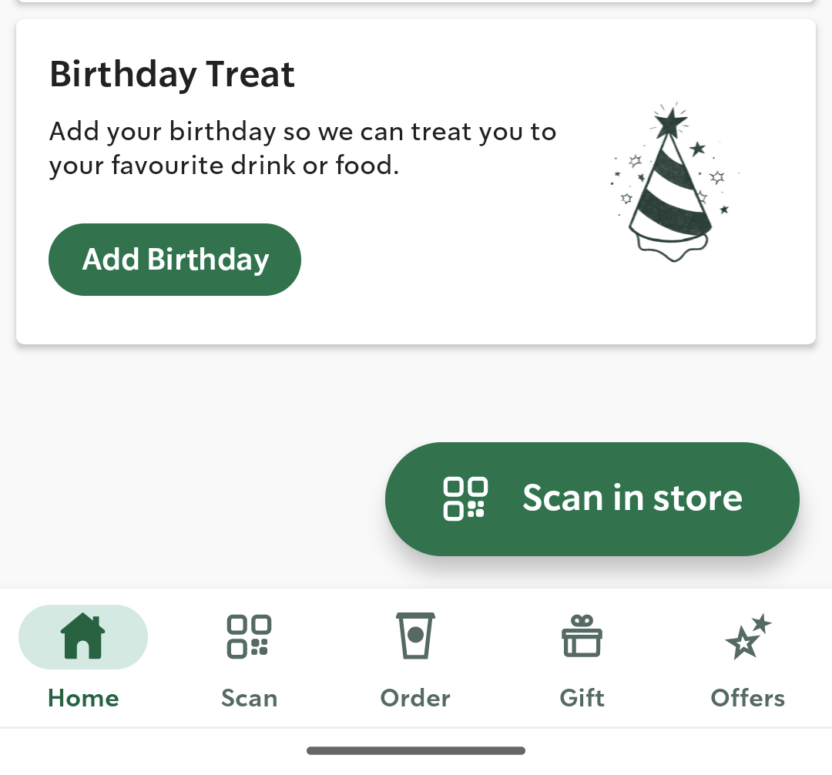
Starbucks has one of the best rewards programs on the market, with an intuitive, simple UI and easy-to-grasp reward system.
But they take everything a step further with the level of personalization they offer. One of their greatest marketing successes is their “Birthday Treat” program. App users can input their date of birth to receive a drink or food offer on their birthday. Not only that, the offer is customized based on their typical buying habits.
A free birthday gift goes a long way in developing the customer relationship, building brand loyalty, and driving engagement. To participate, customers are required to submit their address as well, which provides Starbucks with location data that can be used to further customize offers, products, and the overall experience.
The program is designed to provide customers best-in-class service, make them feel valued and appreciated, and incentivize them to treat Starbucks as their brand of choice. And this focus on the customer experience translates into increased customer engagement, retention, loyalty, and (you guessed it) conversions.
3. DoorDash uses geographic location data to offer curated recommendations
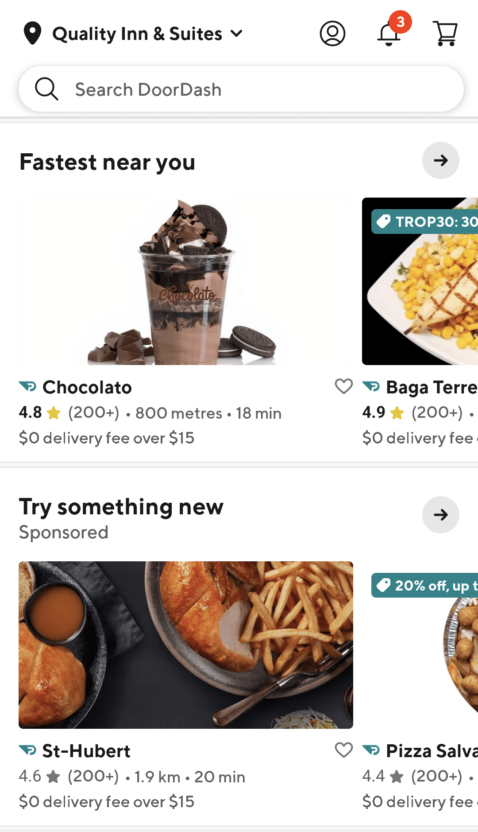
Food delivery services rely heavily on personalization to deliver targeted product recommendations, content, and offers.
By nature, geographic location is a vital component of customer personalization for these companies. After all, even the most delicious, affordable meal is no good if it’s halfway across the world. When people are looking for food, first and foremost, they want food that’s nearby. But delivering this is actually extremely complex. Recommendations need to be dynamic to account for when a user isn’t in their home area.
Beyond that, customers want relevant product recommendations that take into account their dietary restrictions and personal preferences.
DoorDash uses previous purchase behavior to provide targeted recommendations that are more likely to align with the customer’s interests. But DoorDash takes personalized recommendations to the next level.
When a customer searches from a hotel, they provide two automatic filters that make searching for food easier while traveling. The first filters food based on what’s fastest, if you’re on the go and need an expedient option. The second filters food based on what you’ve never had before, helping you find local food options to explore the area you’re visiting.
Both of these simplify the customers’ shopping experience, connecting them with the ideal restaurants faster and more efficiently. Not only does this offer a better user experience, but it drastically increases conversion rates and improves product retention.
4. Uber Eats perfects the timing of push notifications for better engagement
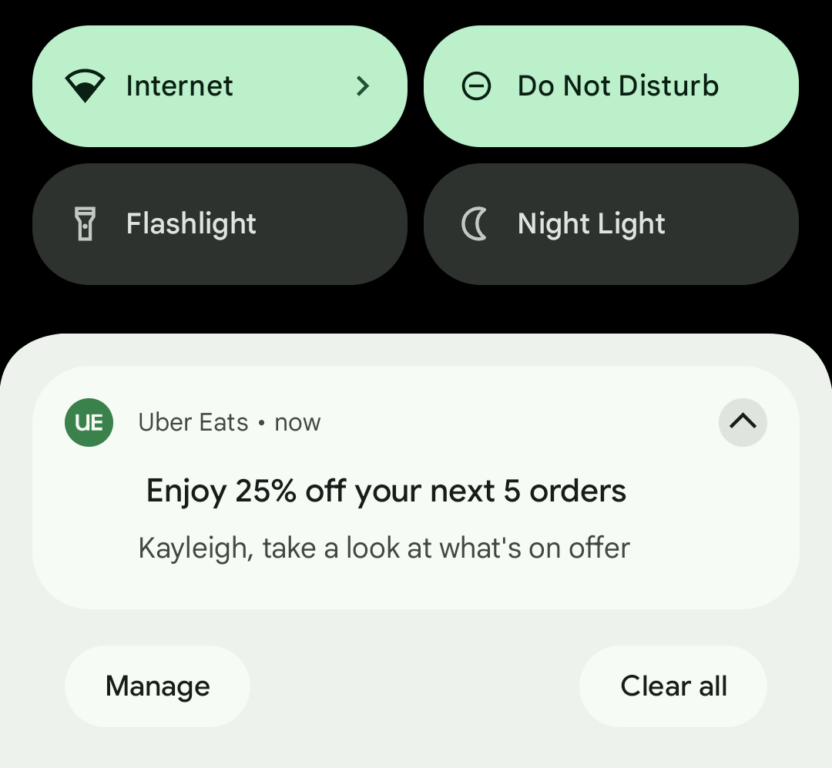
The content of your messages isn’t the only factor to consider — timing is critical. If you miss the mark, your marketing efforts will wall flat and you’ll struggle to see success.
Uber Eats understands how vital the timing of marketing is, and they’ve finely tuned their strategy to time messages perfectly. They deliver push notifications close to when their users would typically order dinner, enticing them to make a buy at the optimal time to elicit a conversion.
The timing of these messages is vital in the quick-service restaurant (QSR) and food delivery industry. Too early, and your customer forgets the message by the time dinner time comes around; too late and your customer has already ordered elsewhere (they may already be eating when your message comes in!).
5. Wealthsimple designs their customer journey for targeted cross-selling
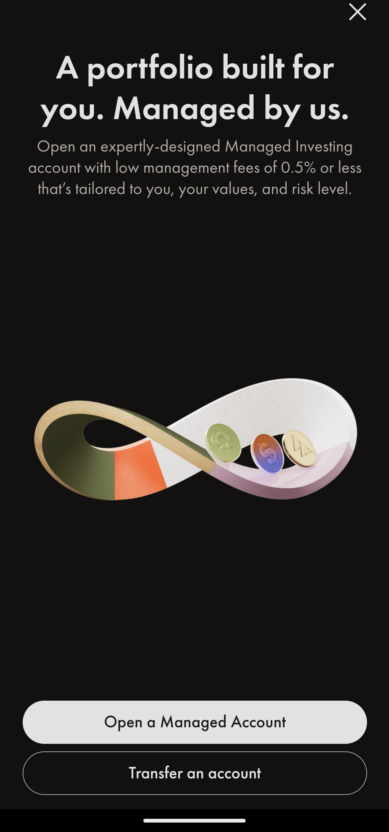
Wealthsimple’s online investment management service leverages their users’ product information to tweak the customer journey ever so slightly to improve conversions. When customers open the app the first time each day, a pop-up ad will recommend a relevant product offering, based on products they don’t currently own and would most likely need based on the products they do have.
Users are also only served with this recommendation the first time they open the app each day, and not every single time they open it. This allows you to create cross-sell opportunities in a conscious way, without compromising regular usability.
6. Toronto-Dominion (TD) Bank creates targeted cross-selling opportunities
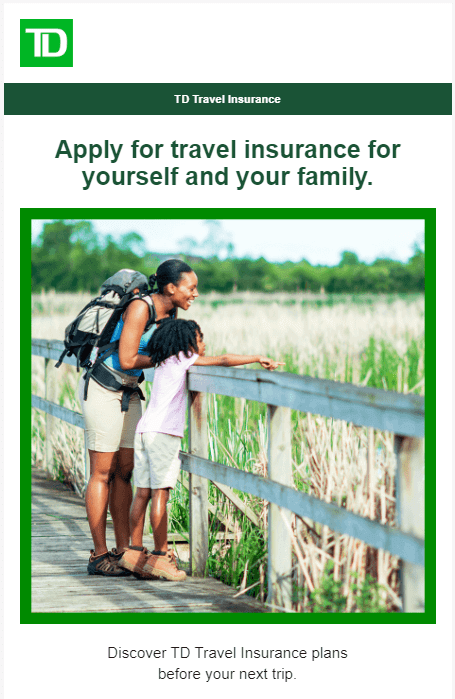
Toronto-Dominion (TD) Bank isn’t just a traditional bank, it’s a large financial institution with a variety of financial products and services. And they do an incredible job of interlinking the marketing and conversation strategies to maximize cross-selling opportunities.
After a customer purchases air travel via a credit card linked to their TD bank account, TD will send an email to the customer offering travel insurance. To do this, TD has to identify a recent credit card purchase, understand the context of the purchase, and then provide a contextually relevant product offering.
Not only does this create a highly targeted cross-sell opportunity, but it also provides the customer with a curated experience that saves them time shopping for what they need.
How to Personalize Customer Experience: A Strategy
As we’ve seen throughout these examples, personalizing the customer experience is a complex undertaking with many moving parts, and all of them need to come together for success. Below, we look at how to develop a personalized customer experience that increases customer satisfaction and engagement.
Step 1: Understand customer expectations and desires
Effective personalization is all about meeting customer expectations and providing users with exactly what they need when they need it. But this is a lot easier said than done, especially when dealing with a large customer base at scale.
Understanding your customers’ wants and needs is imperative to marketing success, from first visit, to lead-nurture, all the way to purchase. Start by asking yourself: who are our customers and what do they want? (And then keep asking yourself that over and over again as you iterate).
Don’t just use your best guess either; collect data on customers to really understand what they’re interested in and what matters to them. Conduct polls and surveys, collect usage and behavior data, and pull in any other insights you can muster to better understand what your customers want from your products and services. Then re-engineer this data to deliver this as effectively as possible.
The biggest challenge with doing this is not all customers want the same thing. When done right, personalization allows you to convey your brand message most effectively for different customer segments.
Overall, your aim should be to help your customers along their journey, and that starts with understanding what they want.
Step 2: Aggregate and consolidate customer data
Personalized experiences don’t just happen on their own, they take significant data analysis and strategic planning.
If you get the messaging or product recommendations wrong, you risk damaging the relationship. If you can’t deliver the level of personalization the customer expects, they’ll look for an alternative that can. When the stakes are so high, you must get the content, tone, and style just right.
To do this properly, you’ll need to have accurate, reliable customer data. If you’re off at all, it could reduce engagement and even lead to customer churn. Having aggregated, consolidated data allows your team to create a holistic view of your customers and their behavioral patterns. The more complete this picture, the better poised you are to execute your personalization strategy.
Step 3: Segment customers into buyer personas
Segmentation is a core process that powers personalization. Quite frankly, without customer segmentation (or with an inefficient system) you’ll always struggle to carry out effective personalized marketing.
Customer segmentation enables you to craft buyer personas that reflect the diversity of your audience, allowing you to understand and connect with your customers on a deeper, more meaningful level through personalized content, messaging, and journeys.
Step 4: Establish an omnichannel strategy
A major component of providing personalized experiences is communicating with your audience via their preferred channels of communication, and unifying these different channels so switching between them is seamless and frictionless.
Don’t just make multiple channels available to your customers, but create an omnichannel strategy that connects these disparate channels to provide a smooth, seamless experience across all user touch points. This ensures users get the same experience no matter where they connect with you, and also ensures that the experience is familiar and satisfactory.
Step 5: Create curated customer journeys
To craft the best-personalized customer experiences, you need to consider the entire end-to-end journey of your customers, factoring in every touchpoint and channel.
Build customized customer journeys that leverage your omnichannel strategy to connect with users via the optimal channel at the right time (across website, mobile, social media, email, SMS messages, and push notifications). Consider all of the consumer touchpoints, treat them as a cohesive experience, and add any channels that seem like they could be advantageous for connecting with different buyer personas.
Remember that journeys should look different for different buyer personas. A mobile customer may be more inclined to respond to a push notification within 5 minutes of an abandoned cart; a web visitor may be more receptive to an email 24 hours after they’ve abandoned the page. Neither is necessarily better at face value, but one may be better for certain customers in certain contexts.
When done effectively, curating personalized customer journeys will help you get customers closer to buying and displaying deep brand loyalty.
Step 6: Provide targeted content and product recommendations
By understanding what your customers actually want, you’re better equipped to provide that for them. And the more you can deliver users what they want (when they want it), the more satisfied they’ll be.
Targeted, personalized content and product recommendations are far more effective at driving engagement and conversions, drastically increasing the likelihood of a conversion. Over time, this also helps you increase average order value (AOV), customer lifetime value (CLV), and overall revenue.
Step 7: Create tailored messages and marketing
No personalized marketing strategy is complete without hyper-personalized messages and marketing materials. Don’t just address customers by name, develop uniquely personal content that is tailored specifically to them, based on the customer segmentation data you’ve collected and the buyer personas you’ve developed.
Meet consumers with the right content, tone, and style based on their interests and preferences to foster a deeper, more meaningful connection. This personal touch makes customers feel valued and appreciated, improving brand trust and loyalty.
Step 8: Leverage AI for faster, better optimization
Don’t just trust that the process is working, leverage big data and AI-driven optimization to identify weaknesses and make improvements that increase traction, retention, and conversions.
Regularly revisit and review your tactics and strategies, individual messages and advertisements, and channel options, adjusting according to what’s most successful and what customers show an interest in. When possible, use AI-powered optimization that automates this process and squeezes out the maximum value from your customer journeys.
Execute Personalized Customer Experiences with MoEngage
Meaningful personalized marketing efforts humanize your company, helping you foster deep, authentic relationships with your customers. In time, this translates into brand loyalty and consistent engagement.
Modern consumers interact with your company across multiple touchpoints and are looking for a cohesive experience no matter how they connect with your brand. To effectively deliver a unified, seamless experience, you need to be conscious about every single touchpoint customers have with your brand — and deeply understand those interactions.
Here at MoEngage, we understand how important it is to connect with your customers. Our Customer Engagement Platform is intuitively designed to help you get the most out of customer interactions by delivering highly personalized customer experiences that connect on a whole different level.
Schedule a demo to learn how we can help you create personalized end-to-end customer experiences that foster intense brand loyalty and drive conversions through the roof.















